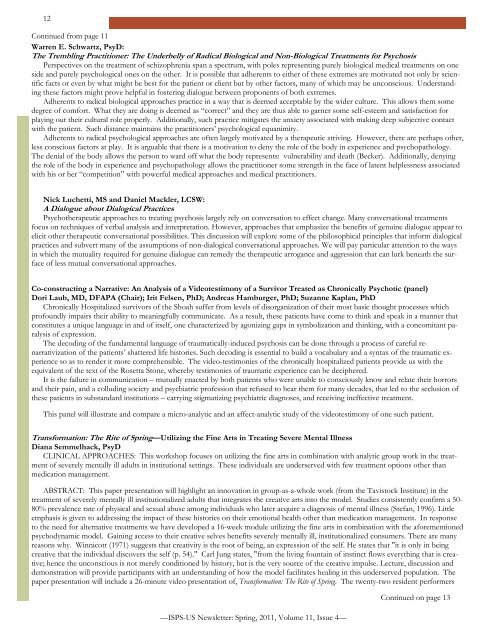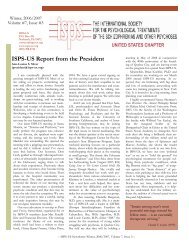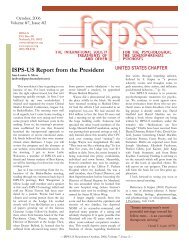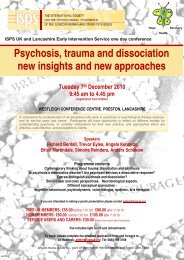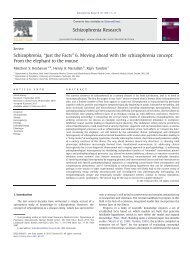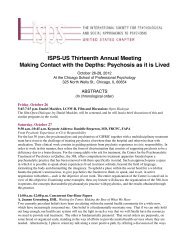Spring 2011 - ISPS-US
Spring 2011 - ISPS-US
Spring 2011 - ISPS-US
Create successful ePaper yourself
Turn your PDF publications into a flip-book with our unique Google optimized e-Paper software.
12<br />
Continued from page 11<br />
Warren E. Schwartz, PsyD:<br />
The Trembling Practitioner: The Underbelly of Radical Biological and Non-Biological Treatments for Psychosis<br />
Perspectives on the treatment of schizophrenia span a spectrum, with poles representing purely biological medical treatments on one<br />
side and purely psychological ones on the other. It is possible that adherents to either of these extremes are motivated not only by scientific<br />
facts or even by what might be best for the patient or client but by other factors, many of which may be unconscious. Understanding<br />
these factors might prove helpful in fostering dialogue between proponents of both extremes.<br />
Adherents to radical biological approaches practice in a way that is deemed acceptable by the wider culture. This allows them some<br />
degree of comfort. What they are doing is deemed as “correct” and they are thus able to garner some self-esteem and satisfaction for<br />
playing out their cultural role properly. Additionally, such practice mitigates the anxiety associated with making deep subjective contact<br />
with the patient. Such distance maintains the practitioners’ psychological equanimity.<br />
Adherents to radical psychological approaches are often largely motivated by a therapeutic striving. However, there are perhaps other,<br />
less conscious factors at play. It is arguable that there is a motivation to deny the role of the body in experience and psychopathology.<br />
The denial of the body allows the person to ward off what the body represents: vulnerability and death (Becker). Additionally, denying<br />
the role of the body in experience and psychopathology allows the practitioner some strength in the face of latent helplessness associated<br />
with his or her “competition” with powerful medical approaches and medical practitioners.<br />
Nick Luchetti, MS and Daniel Mackler, LCSW:<br />
A Dialogue about Dialogical Practices<br />
Psychotherapeutic approaches to treating psychosis largely rely on conversation to effect change. Many conversational treatments<br />
focus on techniques of verbal analysis and interpretation. However, approaches that emphasize the benefits of genuine dialogue appear to<br />
elicit other therapeutic conversational possibilities. This discussion will explore some of the philosophical principles that inform dialogical<br />
practices and subvert many of the assumptions of non-dialogical conversational approaches. We will pay particular attention to the ways<br />
in which the mutuality required for genuine dialogue can remedy the therapeutic arrogance and aggression that can lurk beneath the surface<br />
of less mutual conversational approaches.<br />
Co-constructing a Narrative: An Analysis of a Videotestimony of a Survivor Treated as Chronically Psychotic (panel)<br />
Dori Laub, MD, DFAPA (Chair); Irit Felsen, PhD; Andreas Hamburger, PhD; Suzanne Kaplan, PhD<br />
Chronically Hospitalized survivors of the Shoah suffer from levels of disorganization of their most basic thought processes which<br />
profoundly impairs their ability to meaningfully communicate. As a result, these patients have come to think and speak in a manner that<br />
constitutes a unique language in and of itself, one characterized by agonizing gaps in symbolization and thinking, with a concomitant paralysis<br />
of expression.<br />
The decoding of the fundamental language of traumatically-induced psychosis can be done through a process of careful renarrativization<br />
of the patients’ shattered life histories. Such decoding is essential to build a vocabulary and a syntax of the traumatic experience<br />
so as to render it more comprehensible. The video-testimonies of the chronically hospitalized patients provide us with the<br />
equivalent of the text of the Rosetta Stone, whereby testimonies of traumatic experience can be deciphered.<br />
It is the failure in communication – mutually enacted by both patients who were unable to consciously know and relate their horrors<br />
and their pain, and a colluding society and psychiatric profession that refused to hear them for many decades, that led to the seclusion of<br />
these patients in substandard institutions – carrying stigmatizing psychiatric diagnoses, and receiving ineffective treatment.<br />
This panel will illustrate and compare a micro-analytic and an affect-analytic study of the videotestimony of one such patient.<br />
Transformation: The Rite of <strong>Spring</strong>—Utilizing the Fine Arts in Treating Severe Mental Illness<br />
Diana Semmelhack, PsyD<br />
CLINICAL APPROACHES: This workshop focuses on utilizing the fine arts in combination with analytic group work in the treatment<br />
of severely mentally ill adults in institutional settings. These individuals are underserved with few treatment options other than<br />
medication management.<br />
ABSTRACT: This paper presentation will highlight an innovation in group-as-a-whole work (from the Tavistock Institute) in the<br />
treatment of severely mentally ill institutionalized adults that integrates the creative arts into the model. Studies consistently confirm a 50-<br />
80% prevalence rate of physical and sexual abuse among individuals who later acquire a diagnosis of mental illness (Stefan, 1996). Little<br />
emphasis is given to addressing the impact of these histories on their emotional health other than medication management. In response<br />
to the need for alternative treatments we have developed a 16-week module utilizing the fine arts in combination with the aforementioned<br />
psychodynamic model. Gaining access to their creative selves benefits severely mentally ill, institutionalized consumers. There are many<br />
reasons why. Winnicott (1971) suggests that creativity is the root of being, an expression of the self. He states that "it is only in being<br />
creative that the individual discovers the self (p. 54)." Carl Jung states, "from the living fountain of instinct flows everything that is creative;<br />
hence the unconscious is not merely conditioned by history, but is the very source of the creative impulse. Lecture, discussion and<br />
demonstration will provide participants with an understanding of how the model facilitates healing in this underserved population. The<br />
paper presentation will include a 26-minute video presentation of, Transformation: The Rite of <strong>Spring</strong>. The twenty-two resident performers<br />
—<strong>ISPS</strong>-<strong>US</strong> Newsletter: <strong>Spring</strong>, <strong>2011</strong>, Volume 11, Issue 4—<br />
Continued on page 13


